
Rastafari, sometimes called Rastafarianism, is a religion that developed in Jamaica during the 1930s. It is classified as both a new religious movement and a social movement by scholars of religion. There is no central authority in control of the movement and much diversity exists among practitioners, who are known as Rastafari, Rastafarians, or Rastas.
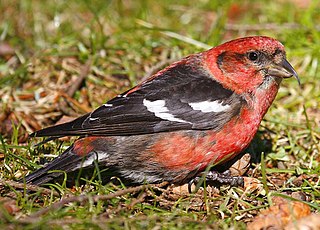
The two-barred crossbill or white-winged crossbill is a small passerine bird in the finch family Fringillidae.

The white-winged lark is a species of lark found from southern Ukraine through Kazakhstan to south-central Russia. It is partially migratory, with birds tending to move south in winter. The southernmost birds are mainly resident. It is a very rare vagrant to western Europe.
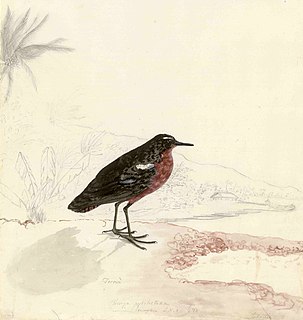
The Tahiti sandpiper or Tahitian sandpiper is an extinct member of the large wader family Scolopacidae that was endemic to Tahiti in French Polynesia.
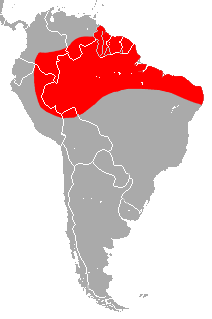
The white-winged dog-like bat is a bat species from South America. It is found in northern Brazil, southeastern Colombia, Ecuador, French Guiana, Guyana, eastern Peru, Surinam and Venezuela.

Gould's petrel is a species of seabird in the family Procellariidae. The common name commemorates the English ornithologist and bird artist John Gould (1804-1881).

The white-winged tanager is a medium-sized American songbird in the family Cardinalidae, the cardinals or cardinal grosbeaks. It is found from Mexico, through Central America, across northern South America and as far south as Bolivia.

Autosticha pelodes, the autosticha gelechid moth, is a moth of the family Autostichidae. It was first described by Edward Meyrick in 1883. It is found in the southern Pacific, including Hawaii and French Polynesia, Java, Sulawesi, the New Hebrides, Samoa, the Austral Islands and the Marquesas. It has been dispersed by humans.

Leucoptera malifoliella, the pear leaf blister moth, ribbed apple leaf miner or apple leaf miner, is a moth of the Lyonetiidae family that can be found in all of Europe.
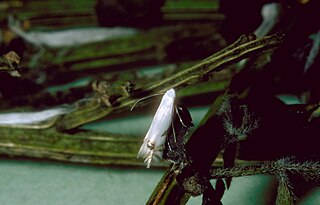
Leucoptera is a genus of moths in the family Lyonetiidae. Its members are leaf borers many of which can cause severe damage to plant crops, such as coffee or apples.

The Autostichinae are a subfamily of moths in the superfamily Gelechioidea. Like their relatives therein, their exact relationships are not yet very well resolved. The present lineage was often included in the concealer moth family (Oecophoridae), but alternatively it is united with the Symmocidae sensu stricto to form an expanded family Autostichidae.

Stoeberhinus testaceus, the potato moth, is a gelechioid moth, supposedly the only species of its genus Stoeberhinus. However, the genus might also include some related moths presently placed in Autosticha. It belongs to the subfamily Autostichinae, which is either placed in the concealer moth family (Oecophoridae), or in an expanded Autostichidae.

Leucoptera laburnella is a moth in the family Lyonetiidae. It is found in most of Europe, except the European part of Russia and the southern part of the Balkan Peninsula. It is also found in North America.
Boondelbah Island, also known as the Boondelbah Nature Reserve, is a protected nature reserve and uninhabited island lying 2 kilometres (1.2 mi) off the mouth of Port Stephens on the coast of New South Wales, Australia. The 14-hectare (35-acre) reserve and island is one of two breeding sites of the nominate subspecies of the threatened Gould's petrel and, with the nearby Cabbage Tree Island which hosts the principal colony, has been classified by BirdLife International as an Important Bird Area.

Autosticha is a genus of gelechioid moths. It belongs to the subfamily Autostichinae, which is either placed in the concealer moth family (Oecophoridae), or in an expanded Autostichidae. It is the type genus of its subfamily. Originally, this genus was named Automola, but this name properly refers to a fly genus in family Richardiidae.

Hakea leucoptera, commonly known as silver needlewood, needle hakea, pin bush or water tree and as booldoobah in Koori language, is a shrub or small tree with rigid, cylindrical, sharply pointed leaves and white, cream-coloured or yellow flowers in late spring and early summer. It is widespread and common in central parts of the Australian mainland.
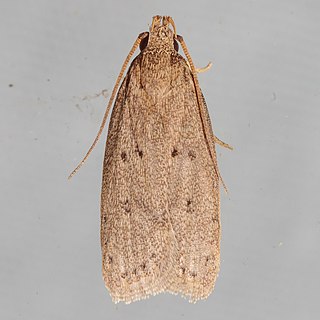
Autosticha kyotensis, the Kyoto moth, is a moth in the family Autostichidae. It was described by Shōnen Matsumura in 1931. It is found in Japan on the island of Honshu. It is an introduced species in the United States, where it has been recorded from Alabama, Florida, Louisiana, Mississippi, North Carolina, Tennessee and Texas.
Autosticha merista is a moth in the family Autostichidae. It was described by Clarke in 1971. It is found on Rapa Iti.













